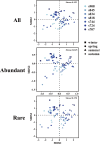Planktonic eukaryotes in the Chesapeake Bay: contrasting responses of abundant and rare taxa to estuarine gradients
- PMID: 38606959
- PMCID: PMC11064499
- DOI: 10.1128/spectrum.04048-23
Planktonic eukaryotes in the Chesapeake Bay: contrasting responses of abundant and rare taxa to estuarine gradients
Abstract
Phytoplankton are important drivers of aquatic ecosystem function and environmental health. Their community compositions and distributions are directly impacted by environmental processes and human activities, including in the largest estuary in North America, the Chesapeake Bay. It is crucial to uncover how planktonic eukaryotes play fundamental roles as primary producers and trophic links and sustain estuarine ecosystems. In this study, we investigated the detailed community structure and spatiotemporal variations of planktonic eukaryotes in the Chesapeake Bay across space and time for three consecutive years. A clear seasonal and spatial shift of total, abundant, and rare planktonic eukaryotes was evident, and the pattern recurred interannually. Multiple harmful algal species have been identified in the Bay with varied distribution patterns, such as Karlodinium, Heterosigma akashiwo, Protoperidinium sp., etc. Compared to abundant taxa, rare subcommunities were more sensitive to environmental disturbance in terms of richness, diversity, and distribution. The combined effects of temporal variation (13.3%), nutrient availability (10.0%), and spatial gradients (8.8%) structured the distribution of eukaryotic microbial communities in the Bay. Similar spatiotemporal patterns between planktonic prokaryotes and eukaryotes suggest common mechanisms of adjustment, replacement, and species interaction for planktonic microbiomes under strong estuarine gradients. To our best knowledge, this work represents the first systematic study on planktonic eukaryotes in the Bay. A comprehensive view of the distribution of planktonic microbiomes and their interactions with environmental processes is critical in understanding the underlying microbial mechanisms involved in maintaining the stability, function, and environmental health of estuarine ecosystems.
Importance: Deep sequencing analysis of planktonic eukaryotes in the Chesapeake Bay reveals high community diversity with many newly recognized phytoplankton taxa. The Chesapeake Bay planktonic eukaryotes show distinct seasonal and spatial variability, with recurring annual patterns of total, abundant, and rare groups. Rare taxa mainly contribute to eukaryotic diversity compared to abundant groups, and they are more sensitive to spatiotemporal variations and environmental filtering. Temporal variations, nutrient availability, and spatial gradients significantly affect the distribution of eukaryotic microbial communities. Similar spatiotemporal patterns in prokaryotes and eukaryotes suggest common mechanisms of adjustment, substitution, and species interactions in planktonic microbiomes under strong estuarine gradients. Interannually recurring patterns demonstrate that diverse eukaryotic taxa have well adapted to the estuarine environment with a long residence time. Further investigations of how human activities impact estuarine planktonic eukaryotes are critical in understanding their essential ecosystem roles and in maintaining environmental safety and public health.
Keywords: Chesapeake Bay; abundant and rare taxa; harmful algal species; planktonic eukaryotes; spatiotemporal variations.
Conflict of interest statement
The authors declare no conflict of interest.
Figures







Similar articles
-
Estuarine gradients dictate spatiotemporal variations of microbiome networks in the Chesapeake Bay.Environ Microbiome. 2021 Nov 27;16(1):22. doi: 10.1186/s40793-021-00392-z. Environ Microbiome. 2021. PMID: 34838139 Free PMC article.
-
Distinct patterns and processes of abundant and rare eukaryotic plankton communities following a reservoir cyanobacterial bloom.ISME J. 2018 Sep;12(9):2263-2277. doi: 10.1038/s41396-018-0159-0. Epub 2018 Jun 13. ISME J. 2018. PMID: 29899512 Free PMC article.
-
Uncultivated Viral Populations Dominate Estuarine Viromes on the Spatiotemporal Scale.mSystems. 2021 Mar 16;6(2):e01020-20. doi: 10.1128/mSystems.01020-20. mSystems. 2021. PMID: 33727395 Free PMC article.
-
Temporal and Spatial Signaling Mediating the Balance of the Plankton Microbiome.Ann Rev Mar Sci. 2022 Jan 3;14:239-260. doi: 10.1146/annurev-marine-042021-012353. Epub 2021 Aug 26. Ann Rev Mar Sci. 2022. PMID: 34437810 Review.
-
Sequencing our way towards understanding global eukaryotic biodiversity.Trends Ecol Evol. 2012 Apr;27(4):233-43. doi: 10.1016/j.tree.2011.11.010. Epub 2012 Jan 11. Trends Ecol Evol. 2012. PMID: 22244672 Free PMC article. Review.
References
Publication types
MeSH terms
Grants and funding
LinkOut - more resources
Full Text Sources

